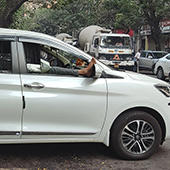Design Case study
Move Mumbai
Kaali Peeli and Beyond
by


“Move Mumbai” is an incredulous yet everyday traffic story from the streets of Mumbai captured through a series of photographs. We closely observe how Mumbaikars use their vehicles, and live with and around them. These vehicles technically are nothing more than machines that were meant to be utilized for transporting people or cargo from place to place.
From cab drivers to bus passengers, from goods carriers to bikers, to children, and pedestrians, Mumbaikars encounter hundreds of vehicles daily while commuting between any two places whether they may or may not be in one themselves. The way people move through their environment is shaped by a wide variety of personal preferences, physical abilities, cultural norms, and socioeconomic status. It could be a matter of necessity for some or a source of leisure for others. It is this diverse human experience that makes every human-vehicle interaction unique.
Every Mumbaikar can recall multiple instances of seeing two-wheelers being used as family vehicles. A vehicle is designed to carry two people. Mumbaikars still manage to fit multiple, especially younger children, in ways that a designer would typically not envision. This reflects in certain ways the economic constraints faced by many Indian families, the cultural value placed on integrated family living, and their resourcefulness. This is one of the many ways in which the city dwellers have appropriated vehicles. We hope that the readers relook at these everyday images with a new pair of eyes to understand the seemingly mundane yet incredulous images of the mobility of Mumbaikars.
This case study is a part of the larger project on "India's Disasters over the Decades" championed by Vivek Kant, HFSS Studios:
https://homepages.iitb.ac.in/~vivek.kant/indian-disasters/
Case Study E-book Download:
• Move Mumbai......

